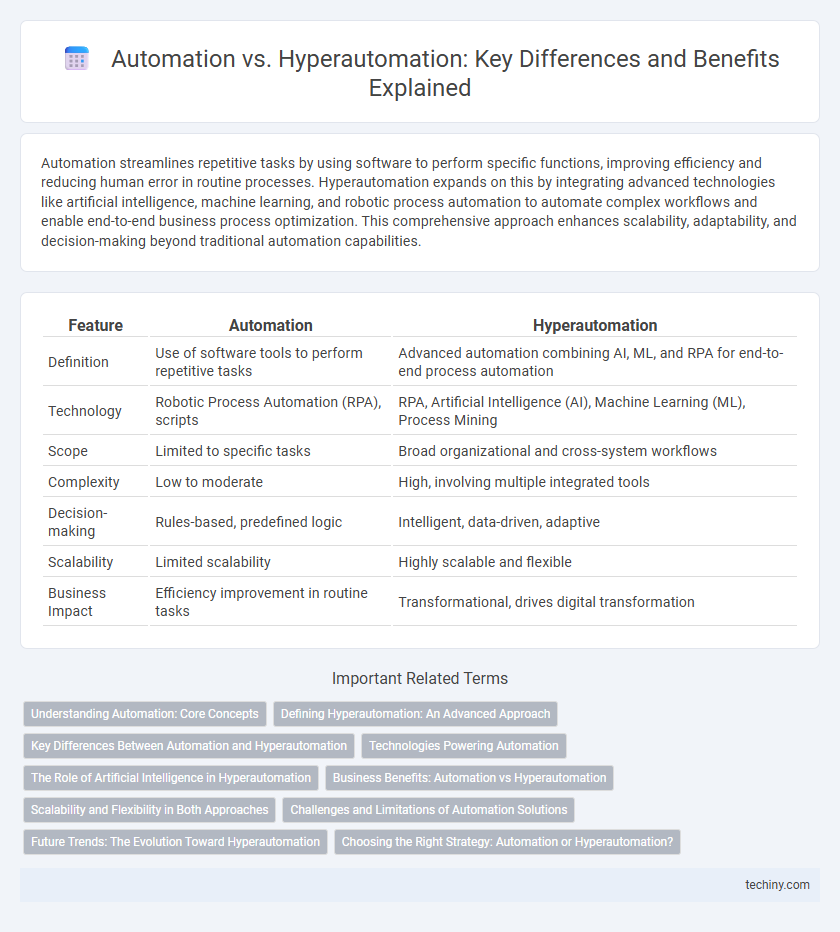Automation streamlines repetitive tasks by using software to perform specific functions, improving efficiency and reducing human error in routine processes. Hyperautomation expands on this by integrating advanced technologies like artificial intelligence, machine learning, and robotic process automation to automate complex workflows and enable end-to-end business process optimization. This comprehensive approach enhances scalability, adaptability, and decision-making beyond traditional automation capabilities.
Table of Comparison
| Feature | Automation | Hyperautomation |
|---|---|---|
| Definition | Use of software tools to perform repetitive tasks | Advanced automation combining AI, ML, and RPA for end-to-end process automation |
| Technology | Robotic Process Automation (RPA), scripts | RPA, Artificial Intelligence (AI), Machine Learning (ML), Process Mining |
| Scope | Limited to specific tasks | Broad organizational and cross-system workflows |
| Complexity | Low to moderate | High, involving multiple integrated tools |
| Decision-making | Rules-based, predefined logic | Intelligent, data-driven, adaptive |
| Scalability | Limited scalability | Highly scalable and flexible |
| Business Impact | Efficiency improvement in routine tasks | Transformational, drives digital transformation |
Understanding Automation: Core Concepts
Automation involves using technology to perform repetitive tasks without human intervention, enhancing efficiency and reducing errors. Hyperautomation expands on traditional automation by integrating advanced technologies like artificial intelligence (AI), machine learning (ML), and robotic process automation (RPA) to automate complex business processes end-to-end. Understanding these core concepts highlights how hyperautomation offers a more comprehensive solution by combining multiple tools to optimize workflows beyond simple task automation.
Defining Hyperautomation: An Advanced Approach
Hyperautomation extends traditional automation by integrating advanced technologies such as artificial intelligence, machine learning, and robotic process automation to automate complex business processes end-to-end. It combines multiple tools and systems to enable continuous process optimization, real-time data analysis, and decision-making automation. This advanced approach drives higher operational efficiency, scalability, and adaptability compared to conventional automation methods.
Key Differences Between Automation and Hyperautomation
Automation primarily involves the use of technology to perform repetitive tasks with minimal human intervention, improving efficiency and reducing errors. Hyperautomation extends beyond automation by integrating advanced technologies such as artificial intelligence, machine learning, and robotic process automation to automate complex processes end-to-end. The key differences lie in scope and capability, where hyperautomation focuses on continuous process optimization and intelligent decision-making across multiple systems.
Technologies Powering Automation
Automation relies on robotic process automation (RPA), artificial intelligence (AI), and machine learning (ML) to execute repetitive tasks with efficiency. Hyperautomation builds on these by integrating advanced technologies like process mining, AI-driven analytics, and intelligent workflow management, enabling end-to-end process optimization. Key technologies powering hyperautomation include AI-based decision engines, low-code platforms, and automated data capture, which collectively enhance scalability and adaptability beyond traditional automation limits.
The Role of Artificial Intelligence in Hyperautomation
Artificial Intelligence (AI) plays a pivotal role in hyperautomation by enabling intelligent process automation that extends beyond traditional rule-based automation. AI technologies such as machine learning, natural language processing, and computer vision allow hyperautomation platforms to analyze unstructured data, make real-time decisions, and continuously improve workflows autonomously. This integration of AI drives higher efficiency, scalability, and adaptability, transforming complex business processes across industries.
Business Benefits: Automation vs Hyperautomation
Automation streamlines repetitive tasks, increasing efficiency and reducing operational costs by integrating software robots to handle routine workflows. Hyperautomation extends these capabilities through AI, machine learning, and advanced analytics, enabling businesses to automate complex processes, improve decision-making, and accelerate digital transformation. Companies leveraging hyperautomation report higher ROI, enhanced agility, and scalable growth compared to traditional automation alone.
Scalability and Flexibility in Both Approaches
Automation streamlines repetitive tasks to enhance efficiency but often faces limitations in scalability and adaptability as processes grow complex. Hyperautomation integrates advanced technologies like AI, machine learning, and RPA to enable scalable solutions that dynamically adjust to evolving business needs. This approach ensures greater flexibility by continuously optimizing workflows and expanding automation capabilities across diverse systems.
Challenges and Limitations of Automation Solutions
Automation faces limitations such as the inability to handle complex, unstructured data and adaptability issues in dynamic environments, leading to scalability challenges. Rule-based automation solutions often struggle with exception handling and require significant manual intervention for maintenance and updates. These challenges highlight the need for Hyperautomation, which integrates AI, machine learning, and advanced analytics to overcome traditional automation constraints.
Future Trends: The Evolution Toward Hyperautomation
Future trends indicate a significant shift from traditional automation to hyperautomation, driven by advancements in artificial intelligence, machine learning, and robotic process automation (RPA). Hyperautomation integrates multiple technologies to create more intelligent, adaptive workflows, improving efficiency and decision-making in complex business environments. This evolution enables organizations to scale automation efforts beyond routine tasks, fostering innovation and continuous digital transformation.
Choosing the Right Strategy: Automation or Hyperautomation?
Choosing the right strategy between automation and hyperautomation depends on the complexity and scale of business processes to be optimized. Automation focuses on streamlining repetitive tasks using robotic process automation (RPA) tools, while hyperautomation integrates AI, machine learning, and advanced analytics to automate end-to-end workflows and enhance decision-making. Enterprises seeking scalable solutions with greater operational agility should opt for hyperautomation, whereas organizations aiming for quick wins in specific departments may find traditional automation more practical.
Automation vs Hyperautomation Infographic

 techiny.com
techiny.com